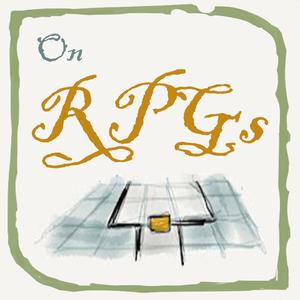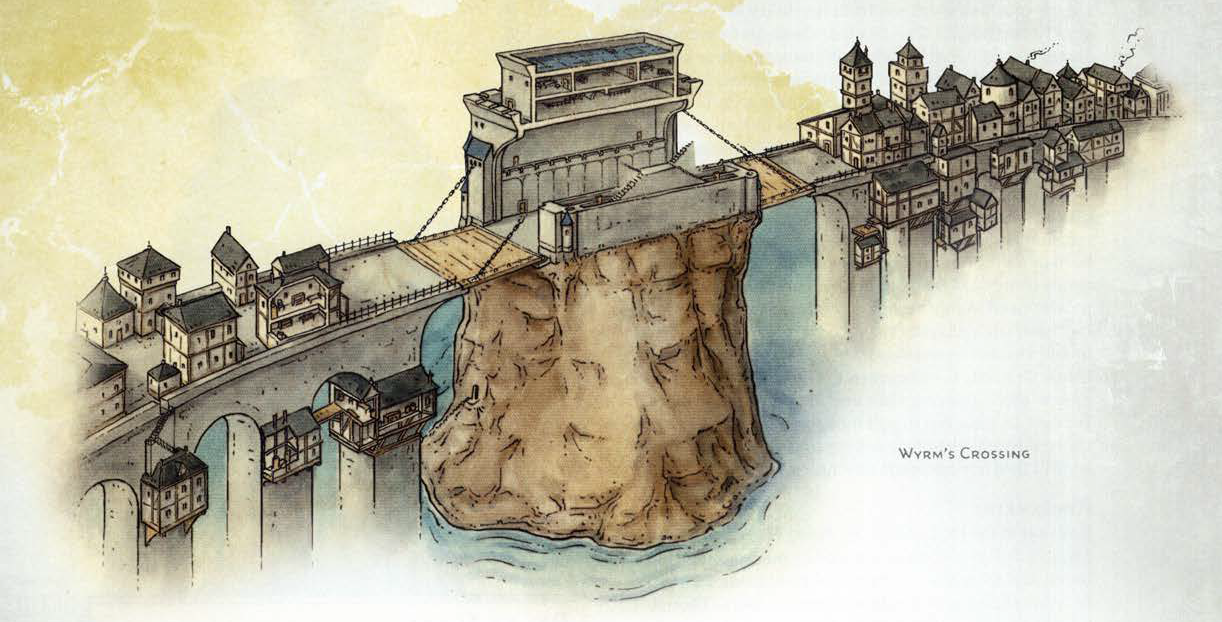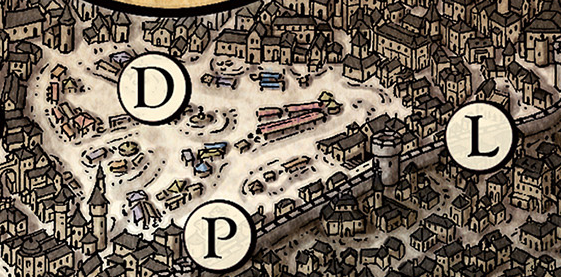In this episode of OnRPGs, I join Donald Dennis and Chris Bell to talk about designing scenarios for cons.
The Lion, the Witch, and the Scenario Hook
She took a step further in — then two or three steps — always expecting to feel woodwork against the tips of her fingers. But she could not feel it.
‘This must be a simply enormous wardrobe!’ thought Lucy, going still further in and pushing the soft folds of the coats aside to make room for her…
Next moment she found that what was rubbing against her face and hands was no longer soft fur but something hard and rough and even prickly. ‘Why, it’s just like the branches of trees!’ exclaimed Lucy.
In C.S. Lewis’ The Lion, the Witch, and the Wardrobe, the four Pevensey children are sent away from London during the Blitz to shelter at a remarkably large house owned by the Professor. In one of the many, many rooms within this mansion there is a magical wardrobe: If you walk into this wardrobe it will act as a magical portal, transporting you to the land of Narnia.
This is Lewis’ scenario hook: In order for the adventures of Narnia to begin, one of the kids needs to walk into the wardrobe.
(We’re going to be talking about the novel in the context of a roleplaying game, so let’s remember that the Principle of Using Linear Mediums as RPG Examples applies.)
Lewis gets away with this, of course, because he’s writing a book. He controls the characters and so it is quite easy for him to (a) make the kids decide to explore the house room by room and then (b) make Lucy climb into the wardrobe and go looking for the back of it.
To be clear: This is not bad writing. Everything the kids do is a perfectly reasonable thing for them to do and completely justified.
But if we imagine C.S. Lewis as a GM running this as a scenario for four PCs, there are several possible ways this could play out:
- The PCs could all find the wardrobe portal together.
- Some of the PCs could find the portal, return, and lead the others into Narnia.
- One of the PCs could find the portal without the others, come back, and then find that the portal has “vanished” due to its strange metaphysics. (But investigation will reveal that it returns.)
- The PCs could all enter the portal separately (or in different groups) and end up making independent alliances with different hostile factions within Narnia.
But, of course, the overwhelmingly likely outcome is that the PCs never find the wardrobe and never go to Narnia, right? Even if they were LARPing this scenario in real-time, they might never go into that room. And, if they did, they could easily never think, “I’m going to try climbing into that wardrobe and seeing if I can touch the back of it.” And it seems to me that while sitting at a table it becomes even less likely for the players to spontaneously conclude that this one particular course of action is what they should be doing. (Or, if they do say something like, “I’m just going to wander around until something interesting happens,” the experience is quite likely to not be particularly satisfying. Turning it into a location-crawl has similar results because the density of interesting material is too low.)
My point is that premises which work just fine in linear narratives from other mediums don’t necessarily work at all when used in an RPG. So if you use those linear narratives as your model for how to prep an RPG scenario, you can end up very frustrated.
SOLUTIONS
One way to handle this would be aggressive scene-framing:
GM: Okay, so you wake up the next morning and it’s raining out. You all decide to play hide-and-seek. Lucy, you go into a room that’s quite empty except for one big wardrobe; the sort that has a looking-glass door. There’s nothing else in there at all except a dead bluebottle on the window-sill. That’s when the door handle starts to turn! You’ve got nowhere else to go, so you pop into the wardrobe! It’s filled with fur coats and there’s a thick smell of mothballs. You head towards the back where it’ll be harder to spot you… only you can’t find the back. This wardrobe is huge! And then…
This works, and it’s based on accurately identifying where the active premise is — the point where the players know what they’re supposed to be doing (or, in a sandbox campaign, where they are made aware that a particular course of action or type of action is available to them). In this case, the active premise is NOT “the Pevenseys have arrived at the Professor’s mansion” (because it is not clear what action they are supposed to be taking there), but rather “Lucy has discovered a magical portal” (because it is immediately apparent that “go through the portal” is a clear action that they can take).
There are drawbacks to such aggressive scene-framing, however: Players will generally feel less immersed and have less ownership of the hook. If it’s handled poorly, players can easily become upset that they’re being forced to do things they don’t want to do. There are some mechanical structures that can address this (like the compel mechanics in Fate), but they generally can’t solve all of the potential problems.
So if we’re currently standing at “the Pevenseys have arrived at the Professor’s mansion,” what other options do we have for getting the PCs an active premise that will take them to Narnia (i.e., hook them into the scenario)?
The first thing I generally try to do when designing a scenario, unless I have a good reason not to, is to make the hook proactive. It’s just a lot easier to use a proactive hook (i.e., one that comes looking for the PCs) than it is to use a reactive one that requires the players to do something to discover it (e.g., search the house to find the wardrobe). For example, we could have stuff coming OUT of Narnia through the wardrobe:
- A strange creature (perhaps a boggart?) that goes rampaging around the house. It keeps damaging stuff and Mrs. MacReady blames the kids for it.
- Refugees from the tyranny of the White Witch.
- Wolves of the secret police pursuing aforesaid refugees.
- Agents of the White Witch who try to kidnap one of the kids and take them back through the wardrobe.
When the PCs question these NPCs or backtrack them, they’ll be led to the wardrobe.
Alternatively, you can look to reframe the active premise. There’s no clean way to say “you need to search the house in order to find the magic wardrobe” if you don’t know the magic wardrobe exists (and discovering that is the whole point to begin with). But what you can do is give the PCs a different reason for searching the house (during which search they will be able to encounter the wardrobe). For example:
- The Professor has died and they need to find his will.
- You provide a game structure by which the kids earn XP by playing childhood games. “Hide ‘n seek” is on the list.
- A stray raccoon gets into the house and Mrs. MacReady tells the kids they need to track it down before the next tour group arrives.
(I talk about this technique at more length in Surprising Scenario Hooks.)
Another option, or perhaps a supplemental one, is to use multiple hooks. This is often just an instantiation of the Three Clue Rule: You include multiple hooks so that, even if the PCs miss some of the hooks, they’re still likely to get at least one of them. (One of the corollaries of the Three Clue Rule is permissive clue-finding, and you can often achieve a similar effect through organic scenario hooks — i.e., hooks that emerge from the actions of the PCs rather than being pre-planned.)
For example, rather than it being specifically the wardrobe that’s magical, we could say that the entire estate is magical and/or that there’s some powerful fey magic trying to draw the children to Narnia. No matter what they do, we can improvise a hook that offers them a path to Narnia. They go to play Poohsticks in the stream? They find their sticks disappearing through a magical shimmer under the bridge. They help the cook make dinner? They discover a secret passage behind the wine rack in the cellar when they’re sent down for supplies. They read books in the library? They open a magical book! They play hide ‘n seek? Wardrobe!
Design Note: Isn’t the wardrobe a magical portal because it’s made from wood taken from Narnia? How do you square that with there being magical portals all over the damn place?
First, keep in mind that we’re just using the book here as an example. In practice this would be a scenario you’re designing yourself, and you can do whatever you want.
Second, this is actually an interesting example: Lewis didn’t know that the wardrobe was made of wood from Narnia when he wrote The Lion, the Witch, and the Wardrobe. The wardrobe was just a cool thing he thought up and then he BUILT on that continuity later on. We could imagine the same thing in our hypothetical campaign: The PCs go to play Poohsticks and you improvise a magical bridge; later it occurs to you that the bridge could have been built out of wood from Narnia. Or the magical book in the library turns out to have been the diary the Professor kept during his own adventures in Narnia. After discovering stuff during play you’re free to continue building on it and making new discoveries about your world.
Third, if it is important that the portal be in the wardrobe made from Narnian wood — whether to the scenario, your metaphysics, or just your personal taste — then use one of the other options.
On that note, what if you really do need a reactive premise? For example, you want them to simply stumble across the wardrobe accidentally? In that case, you need to have other active premises in the house to engage the players until the reactive premise can be presented. Basically, you have other adventures (or, at least, interesting things that the PCs are aware they can interact with) happening in the mansion. And then, at some point during those adventures, the wardrobe can appear. (Or maybe it appears several times as part of the background scenery, until the revelation finally happens.)
You can also take a laidback approach to his by asking each player to describe what a typical day at the house looks like for their character. This frames the action declaration at a sufficiently abstract level that the players aren’t trying to fill the minute-to-minute activities of their lives, but it also makes it clear that the active premise is defining routine (specifically, in this case, what the “new normal” looks like for the kids). You can ask questions like:
- After you’ve said good night to the Professor and gone upstairs to your rooms on the first night, what plans do you make for the next day?
- What if it’s a rainy day and you can’t go outside? What do you do?
- It’s been a week and you’re getting bored. What do you do to mix things up?
What you’re looking for as the GM, of course, is the opportunity to say, “While you’re doing that, you happen to see this wardrobe and that’s when the adventures begin…”
As a campaign develops over time, the group will often develop a collective sense of what a “normal day” looks like in any case. This knowledge makes it easier to aggressively frame scenario hooks without the players feeling as if their toes are getting stepped on… which brings us full circle.
Note: In a storytelling game you can use a variant of this technique to simply cut to the chase by giving the players narrative control. You could turn to Peter’s player, for example, and say, “Somewhere in this house there is a portal to the magical land of Narnia. What is it?” And after Peter’s player has said that it’s a wardrobe, you could turn to Lucy’s player and say, “And how do you find this portal?” Similar approaches using the specific mechanics of the storytelling game are also quite common.
REJECTING THE CALL
Sometimes your players will encounter the hook and reject it. There’s often nothing wrong with this! Rejecting the call to adventure is an official part of the Campbellian Hero’s Journey™! (And if you’re running a sandbox campaign, there should be so many scenario hooks hanging around that it would be surprising if the PCs didn’t reject a few of them.)
This rejection can also happen unintentionally. For example, you might design the metaphysics of the wardrobe so that the portal only works intermittently, with the expectation that the players will investigate the wardrobe and figure out the timing. Instead, Lucy finds the portal and comes back, but when she tells the others about it and the portal doesn’t work, the other characters assume she’s just telling funny stories.
So things reset and, later, Lucy goes back into the wardrobe and this time Edmund sees her and follows her. And you think, “I’m so glad he’s got in too! The others will have to believe in Narnia now that both of them have been there. What fun this will be!” But then Edmund’s player tests his Liar personality trait, fails, and says, “Oh, yes, Lucy and I have been playing – pretending that all her story about a country in the wardrobe is true. Just for fun, of course. There’s nothing there really.”
And this prompts some simply amazing roleplaying between the PCs, but the hook of the wardrobe has once again been rejected and it’s all so horrid that now Lucy won’t go near the wardrobe for fear of being teased and none of the others even want to talk about it.
If you were running a sandbox, it might be fine to just let the wardrobe go at this point (as noted above, there would be lots of other hooks for the PCs pursue). And even if you’re running a specific scenario (we’re supposed to be playing in Narnia, not stuck in the mansion!) it can easily be the case that the stuff spinning out from a rejected call to adventure is more than interesting enough to entertain everybody for the entire session. (The stuff with Edmund lying, for example, is really interesting and likely to have a long-term impact on the campaign that’s truly fascinating. Don’t choke it off!)
But in either case, you’ll usually want to offer the hook again – either because this is the scenario you’re supposed to be playing tonight or because the scenario is part of the environment and it will naturally keep crossing paths with the PCs. (If you design the scenario with multiple hooks in the first place, this will often happen organically without any especial effort on your part.)
There can be a natural impulse to make the returning hook more aggressive – they missed it the first time, so it clearly needs to be even more obvious and in-their-face the second time! But this is often (although not always) the wrong choice. The players will have often chosen to reject the hook. That’s a meaningful choice and directly overriding it simply for the sake of overriding it is railroading.
(This is more or less what Lewis does in the book: The kids are relentlessly pursued by Mrs. MacReady’s tour group until they have absolutely no choice but to all leap into the wardrobe together. But, of course, it’s a book.)
Even if the players have just flat out missed the first hook, it’s still usually not necessary to use an aggressive hook. If they literally missed it, then the second hook will effectively be their first hook and there’s no need to make it special. If they misinterpreted the hook or didn’t realize that it was a hook, the second hook will usually serve to reinforce the first one and, thus, be stronger collectively regardless. (“Oh! That’s what the crazy rune-writing meant!”)
The exception tends to be when the rejection of the first hook carries obvious consequences that are going to be aggressive. For example, if the PCs choose to just ignore Old Joe’s gang threatening to burn down their ranch… well, Old Joe’s gang burning down their ranch is probably going to be pretty aggressive.
PROACTIVE PLAYERS
Proactive players are the ones who will pursue courses of action even when they haven’t been presented with an active premise for that action.
For example, in my OD&D open table one of the PCs spontaneously decided to buy up all the garlic in the local community and then use their monopoly to jack up the prices. (They knew that the local adventurers had discovered vampires and had concluded that the demand was about to spike.) The result was the creation of the Halfling Mafia, who grew to become a pervasive presence in the campaign.
That’s an example of proactive play: There was no “buy up all the garlic and form a mafia” hook that I had put into play.
By contrast, in my current Blackmoor open table I use a set of Special Interest XP rules that specifically encourages PCs to, for example, set up philanthropic societies. So when one of the PCs decided to set up the Vampire Awareness and Relief Foundation, that was really awesome, but it wasn’t proactive play. (The mechanical structure had offered the active premise of setting up philanthropic societies.)
Some players are naturally proactive. Others will never be so. (And that’s okay!) But often proactive players are created in the sandbox: When they are inundated with scenario hooks and it becomes clear that THEY are empowered to choose what they will do next, often the leap will be made that they do not need to choose but can instead create.
When you say, “You’ve arrived at the Professor’s house. What do you want to do?” a reactive group, in the absence of an active premise, will stare at your blankly. But if you have proactive players, don’t feel like you need to immediately start hurling scenario hooks at them. Let the Pevenseys tell you what they’re going to do and follow their lead, giving them the incredible reward of knowing that the action THEY created is the one which sets everything into motion. It is the proactive player who will say, without prompting, “I’m going to explore the house!”
Everyone agreed to this and that was how the adventures began. It was the sort of house that you never seem to come to the end of, and it was full of unexpected places. The first few doors they tried led only into spare bedrooms, as everyone had expected they would; but soon they came to a very long room full of pictures and there they found a suit of armor; and after that was a room all hung with green, with a harp in one corner; and then came three steps down and five steps up, and then a kind of little upstairs hall and a door that led out onto a balcony, and then a whole series of rooms that led into each other and were lined with books — most of them very old books and some bigger than a Bible in a church. And shortly after that they looked into a room that was quite empty except for one big wardrobe…
FURTHER READING
Design Notes: Scenario Hooks for Over the Edge
Juggling Scenario Hooks in the Sandbox
Surprising Scenario Hooks
Players Who Won’t Bite
Bringing the PCs Together
Remixing Avernus – Part 4A: The Road to Candlekeep
THE CANDLEKEEP REVELATIONS
In order for Descent Into Avernus to continue beyond this point, the PCs need to go to Candlekeep and have Sylvira Salkiras open the infernal puzzlebox. (Theoretically they could also figure out an alternative way of opening the puzzlebox and also an alternative method of getting to Hellturel after they do so. More power to them.)
There are two things that are required for this to happen.
FIRST: The PCs must have possession of the infernal puzzlebox. In Part 3C: The Vanthampur Revelations we added multiple clues pointing to the existence (and importance) of the puzzlebox specifically so that the PCs would know to look for it when they went to Vanthampur Manor. (If they brief Zodge or Marshal Portyr on this information, they will also encourage the PCs to seize the puzzlebox due to its obvious importance to the cultists.)
SECOND: The PCs must know to take it to Candlekeep in order to open it. There are three ways for the PCs to learn this:
- Falaster Fisk can recognize the puzzlebox and tell them that Sylvira Salkiras has opened similar boxes in the past.
- If the PCs research the puzzlebox (with an Intelligence (Arcana or Religion) check), they can learn the basic properties of the puzzlebox and also be pointed in the direction of Candlekeep as a place where they could learn even more. (This wouldn’t necessarily identify Sylvira, but could. If it doesn’t, they’ll be pointed in her direction once they start making inquiries at Candlekeep.)
- Marshal Portyr will order them to take the puzzlebox to Candlekeep to find out what it is (or strongly support that action if they’ve already proposed it). (As also discussed in Part 3C and Part 3J, she will be interested in getting the PCs out of Baldur’s Gate until the political heat from the assassination of the Vanthampurs dies down. This is as good a reason as any and the puzzlebox is an enigma she’d like solved in any case.)
It would also be useful for the PCs to learn that they need to donate a unique book as an entrance gift in order to gain entry to Candlekeep before they leave Baldur’s Gate (because this will give them an opportunity to obtain one). Any of the leads above (Fisk, research pointing them to Candlekeep, Portyr) can and should inform them of this.
DOWN THE COAST WAY
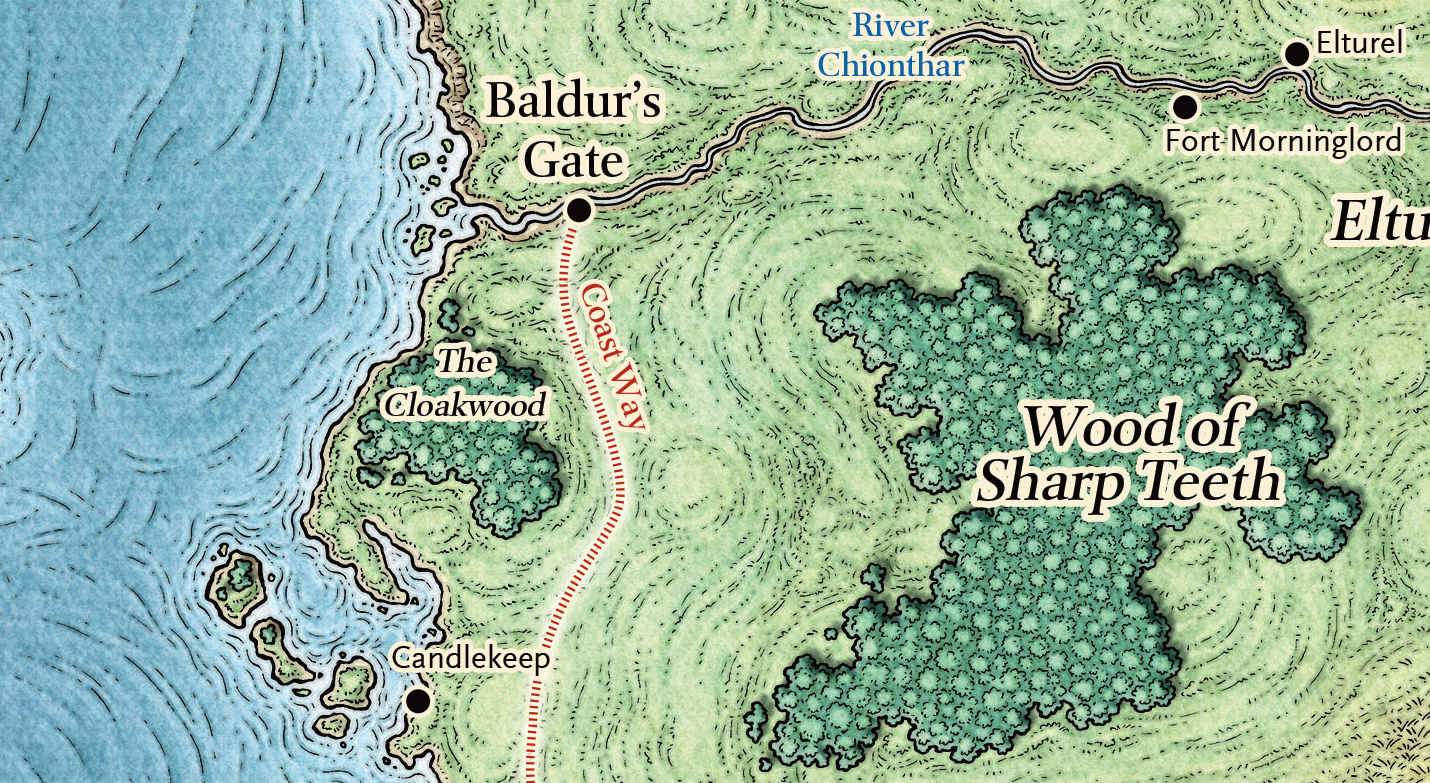
The thing that I immediately notice about the “Journey to Candlekeep” (DIA, p. 43-44) is the obvious missed opportunity: The refugees from Elturel.
If refugees are pouring down the Chionthar River and then being turned away from Baldur’s Gate, then they’re going to start heading north and south along the Coast Way. As we discussed in Part 1, the plight of the refugees is the emotional connection that the PCs (and players) have to Elturel. At this point we’re heading straight towards the campaign-changing revelation that ELTUREL WAS NOT DESTROYED, so this is the perfect time to refresh the thematic work we laid down at the beginning of the campaign.
As written in Descent Into Avernus there are three encounters along the road. None of them currently feature the refugees, but with a few simple tweaks all of them COULD.
WYRM’S CROSSING
Wyrm’s Crossing is a cutpurse’s paradise, and every traveler here runs the risk of being pickpocketed. As the characters make their way from one end of Wyrm’s Crossing to the other, have each player roll a d20. (Don’t roll for NPCs traveling with the party.) The character or character with the lowest roll are targeted by a pickpocket.
(Tangentially: If you want to randomly pick one of the PCs, just roll a die on your side of the screen. Asking the whole table to roll d20s, then collecting and comparing that data is a terrible technique. You’re wasting your players’ time with busy work.)
As written, the pickpocket is a generic encounter that’s resolved, one way or another, without interaction from the PC who’s targeted:
Use a character’s passive Wisdom (Perception) score to determine whether a theft made against that character is successful. If the character’s score is 11 or higher, the theft is detected and thwarted. Otherwise, the thief makes off with one item weighing 1 pound or less (such as a coin pouch or potion).
REFUGEE TWIST: The pick pocket is a refugee. A kid named Frens Nölruth (bandit, MM p. 343). If at all possible, he’s not grabbing money, but snatching rations.
If the PCs catch Frens, they’ll have to decide what to do with a refugee who’s simply hungry and desperate. If they don’t then when they discover the theft they’ll reflect on the fact that someone in the pressing throngs of refugees could have taken their coin purse, but instead took their bread.
KNIGHTS OF THE SHIELD
In this road encounter, the PCs are ambushed by a devil disguised as a local farmer.
Coming up the road toward you is a human farmer riding on the front of a hay-filled wagon pulled by two draft horses. The farmer gives you a friendly wave as the wagon draws near.
REFUGEE TWIST: The bad guys aren’t disguised as local farmers. They’re disguised as refugees; one of the many families or small groups that the PCs have been passing on the road all day.
(These small clots of refugees are an additional encounter in their own right: Describe them. Give the PCs a chance to respond to them — providing succor where they can, riding past while studiously ignoring them, whatever — and then after that describe the devil leaping out of a group they pass further down the road.)
Design Note: As scripted, these are Knights of the Shield ambushing the PCs in an effort to grab the Shield of the Hidden Lord. There’s a bunch of ways that this might not make sense (the PCs might not have the Shield or they may not have encountered any Knights who could report that they had the Shield), but it’s not terribly hard to justify: Marshal Portyr might have a leak in her organization, for example.
On the other hand, the essential beat here is “trouble is following you from Baldur’s Gate.” It’s a minor beat, but it provides a nice sense of pressure on the group. You can achieve this same effect by having some other faction that the PCs have pissed off attempt to ambush them (remnants of either Cult of Zariel are an obvious choice).
Avoid the Quantum Ogre, however: If the PCs specifically take efforts to sneak out of Baldur’s Gate undetected, use some kind of appropriate counter-intelligence resolution to see if they’re successful. (And, of course, if they are, they can’t be ambushed.)
TALE OF THE HELLRIDERS
The final encounter has Reya Mantlemorn share the history of the Hellriders with the PCs while they’re gathered around the campfire.
REFUGEE TWIST: If you’ve eliminated Reya Mantlemorn as a GMPC (see Part 2) this is actually a great time to leverage the character. She’s been riding up and down the road helping refugees in need; seeing their campfire she approaches, thinking at first they might be refugees, but then welcoming a chance to rest for a little while.
Alternatively, if Reya IS journeying with the PCs, their camp can be similarly approached by another Hellrider (Bran Nestoon). Reya is excited to share news with a fellow Hellrider. Later, or prompted by something in that shared news, Reya and Bran share the history of the Hellriders with the PCs.
REVISED TALE: One important revision to how lore is being handled in the Remix is that it is NOT widely known that Zariel, the Archduchess of Avernus, was once the same angel who led the Charge of the Hellriders.
We’ll be delving into the full history of the Charge of the Hellriders (as I call it) in Part 6D of the Remix, where we’ll also be straightening out the continuity glitches around it. The key thing for right now is that Zariel is nameless, so that her role in the Charge can come as a revelation (see Part 4C).
ARRIVING AT CANDLEKEEP
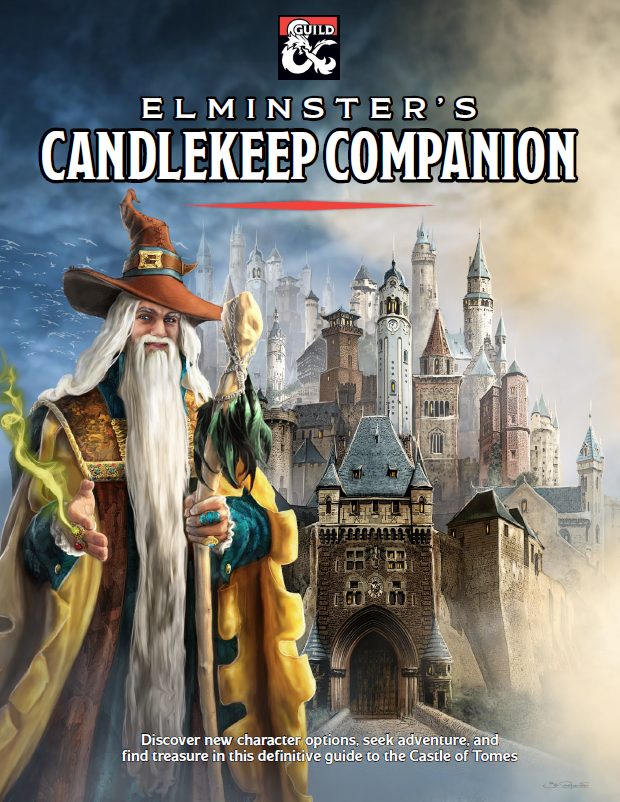 If you really want the PCs’ brief sojourn at Candlekeep to pop, I recommend checking out Elminster’s Candlekeep Companion on the Dungeon Masters Guild. It features a ton of play-oriented material that not only highlights the stuff that’s cool about the Castle of Tomes, but also gives you the tools to inject those cool things directly into your game.
If you really want the PCs’ brief sojourn at Candlekeep to pop, I recommend checking out Elminster’s Candlekeep Companion on the Dungeon Masters Guild. It features a ton of play-oriented material that not only highlights the stuff that’s cool about the Castle of Tomes, but also gives you the tools to inject those cool things directly into your game.
Start with the PCs arriving at Candlekeep: The book gives you plentiful detail on the procedures around the presentation of the entrance gift. (And when the PCs are looking for potential entrance gifts back in Baldur’s Gate, the Candlekeep Companion also includes a random table of books that you can use.)
Once they’ve gained admittance, build their journey through the tangled halls of Candlekeep. The Companion features a number of random tables for determining the rooms, towers, and passages they go through while traveling from one place to another.
(The Candlekeep Companion also features a beautiful poster map of Candlekeep by Marco Bernardini that’s well worth using.)
Note: If the PCs weren’t guided to Candlekeep by Falaster Fisk, they won’t be looking for Sylvira when they arrive. This isn’t really a problem: The minute they start making inquiries about infernal affairs or the infernal puzzlebox, they’ll be pointed in her direction.
RESEARCH AT CANDLEKEEP: The Companion also includes guidelines for conducting research at Candlekeep. If you want to make sure the PCs have the full Candlekeep experience, I recommend tweaking Sylvira’s ritual for opening the infernal puzzlebox so that it takes most or all of a tenday (we can imagine the puzzlebox suspended in the energy fields of some strange, technomantic device as its fractal layers are slowly unraveled one by one).
SYLVIRA & TRAXIGOR
As designed, this section of Descent Into Avernus is:
- The PCs are told to travel to a loremaster who lives in a castle.
- They do so.
- The PCs are told to travel to a loremaster who lives in a tower.
- They do so.
It’s kind of repetitive and also feels fairly pointless. The adventure even goes so far as to say:
Although Sylvira can prepare the plane shift spell, there’s no point, as magical wards placed on Candlekeep prevent creatures from using such means to go to or from the library.
Which is just silly because… walk out the front gates and cast the spell.
I’d recommend either conflating these two characters into one (in which case I’d pick Traxigor as I find the magical otter to be an infinitely more interesting character) or simply put them both in the same lab at Candlekeep as partners.
The rough sequence probably looks like this:
- PCs meet Sylvira and Traxigor.
- The PCs show them the infernal artifact(s) they have.
- Sylvira and Traxigor begin sharing their lore on those (see Part 4B).
- At some point during this, Lulu comes flying into the room. She’s here sharing her memories of Hell with Sylvira and Traxigor, aiding them in their research. She might even have something to add on the infernal puzzlebox or Gargauth’s history. (This, of course, assumes that Lulu isn’t being played as a PC, see Part 2.)
- Sylvira opens the infernal puzzlebox.
- They establish why the PCs need to go to Avernus (see Part 4B).
- The PCs help Traxigor look for his lost tuning fork.
- Traxigor leads the PCs out of Candlekeep (when they’re ready) and plane shifts them to Hellturel.
LAB RUMMAGING:
Characters can help Traxigor search for his missing tuning fork, which is keyed to the Nine Hells. Whoever rolls the highest Wisdom (Perception) check finds the tuning fork. Whoever rolls the lowest finds a random trinket, determined by rolling on the Trinkets table in chapter 5 of the Player’s Handbook. Traxigor doesn’t care if the characters keep the trinket or not, and doesn’t remember how or when he acquired it.
I really like this mechanical interaction: It’s a nice, subtle touch to reward the low roll in addition to the high roll, coupled to imagery that reinforces the environment. If you want to add a little more sizzle, consider using 101 Curious Items or the random oddities tables from Arcana of the Ancients. (If you want to add A LOT of sizzle, use the random cypher tables from Arcana of the Ancients.)
Remixing Avernus – Part 3J: Portyr Assassination
At the Dungeon of the Dead Three, the PCs discover that Duke Vanthampur has ordered the assassination of Duke Dillard Portyr during a speech he’s giving at a charity event for the Confraternity of Refugee Relief.
DUKE DILLARD PORTYR: See Descent Into Avernus, p. 162. He was once the Grand Duke (see Murder in Baldur’s Gate, p. 36), but now isn’t for some reason. He’s the uncle of Marshal Liara Portyr.
CONFRATERNITY OF REFUGEE RELIEF: Established by Duke Portyr, this secular charitable organization seeks to raise funds and provide relief to the Elturian refugees. Whereas other figures of power in the city are panicked about the disruptive force of the refugees, Portyr is both legitimately concerned about them and has also made the mental calculation that, if Elturel has truly fallen, the refugees probably aren’t going anywhere — there’s going to end up being a Little Elturgard outside the city walls and a significant chunk of the city’s population will be made up of former refugees. If they all have a friendly opinion of or even feel indebted to the Portyrs, that could be a lasting political legacy.
THE EVENT: The confraternity has been organizing free meals for refugees and has commandeered (under Portyr’s authority) a section of the Wide around the statue of the Beloved Ranger to do so:
Today, Duke Portyr plans to stand on the base of the Beloved Ranger and give a speech pledging his support and the support of Baldur’s Gate to succor the refugees.
THE ASSASSINATION
As the PCs rush into the Wide, they see Duke Portyr mount the Beloved Ranger and begin giving his speech.
I would like to lead my fellow citizens of Baldur’s Gate in welcoming our Elturian friends! I know that times are difficult now, but we will find a way to persevere — TOGETHER!
There have always been those who thought the people of Baldur’s Gate and the people of Elturel must live in strife. But Amaunator has given us a gift of time; the gift of a precious moment in which to see that we are not rivals, but rather brothers joined by the waters of the Chionthar. And if we stand together—
THE INFERNAL ARROW: That’s as far as Duke Portyr gets before a blood-red arrow, glowing with infernal light, streaks from the crowd from and strikes him in the chest. The Duke staggers, 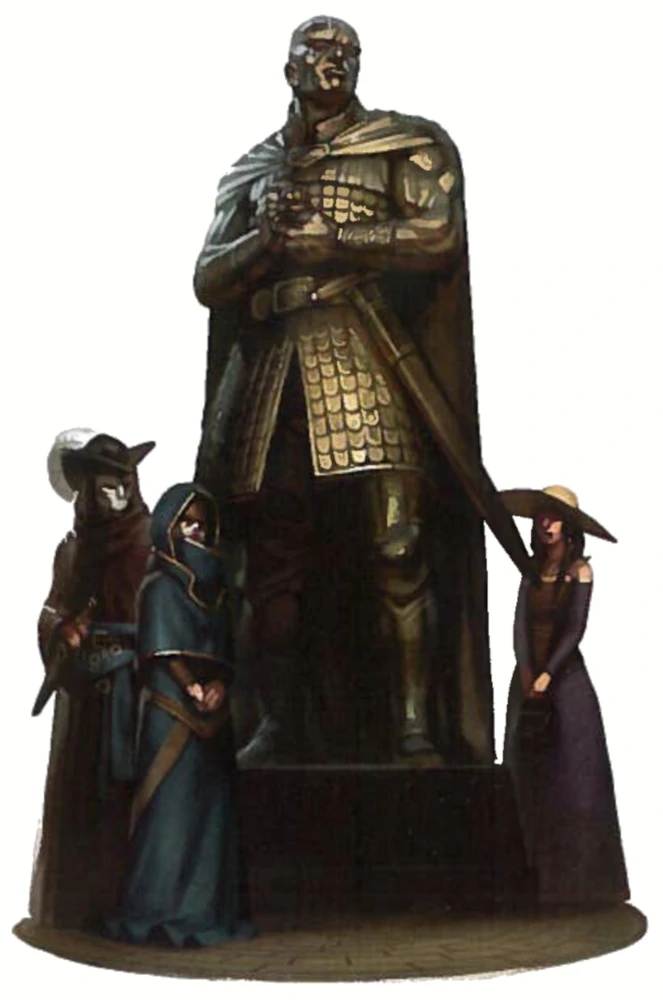 gasps, and then explodes in a shower of blood and gore. Several devils climb out of his putrid remains before tearing into his guards with vile glee.
gasps, and then explodes in a shower of blood and gore. Several devils climb out of his putrid remains before tearing into his guards with vile glee.
If the infernal arrow is recovered it will be found to still glow red hot (1d4 fire damage if picked up without gloves) for 1 minute, but its one-use conjuration effect has been used up.
THE DEVILS: Two imps (MM, p. 76) and four nupperibo (Mordenkainen’s Tome of Foes, p. 168). They’ll attack Portyr’s guards and then the crowd, unleashing panic across the Wide. At the start of each round, roll 1d6 to determine a random complication:
- A young child falls nearby and is in danger of being trampled to death unless someone takes an action to save them.
- The riotous crowd swirls around the group, reducing their speed by 10 feet.
- A member of the crowd grapples (+0) a character (escape DC 10), screaming for help.
- A random character stumbles on a pothole and must succeed on a DC 15 Dexterity saving throw or fall prone.
- An overzealous guard (MM, p. 347) thinks the PCs are working with the assassins or devils or both and attacks!
- The statue of the Beloved Ranger is toppling over. A random character must make a DC 14 Dexterity saving throw or be crushed beneath it for 2d6 bludgeoning damage (they also fall prone and a DC 18 Strength check is required to lift the statue off of them).
THE ASSASSINS: The shot was taken by a night blade (DIA, p. 233) accompanied by four fists of Bane (DIA, p. 232). They strategically located themselves near an entrance to the Undercellar (DIA, p. 182) and will attempt to escape through its labyrinthine depths.
CHASE THROUGH THE UNDERCELLAR: If the PCs give chase, the assassins may try to split up. Use the chase rules from the DMG (p. 252). Complications can include:
- The chase goes through the middle of a pit fight between two giant weasels (MM, p. 329). You either need to circle the pit (40 feet of additional movement) or suffer an opportunity attack from a weasel.
- A crowd blocks the way. Make a DC 10 Strength (Athletics) or Dexterity (Acrobatics) check. On a failure, the crowd counts as 10 feet of difficult terrain.
- A maze of barrels, crates, or similar obstacles stands in the way. Make a DC 10 Dexterity (Acrobatics) or Intelligence check to navigate the maze. On a failed check, it counts as 10 feet of difficult terrain.
- The ground is slipper with rain, spilled oil, or some other liquid. Make a DC 10 Dexterity saving throw. On a failed save, you fall prone.
- The assassins slam and lock an iron gate shut as they pass through it. It costs them 10 feet of movement, but it will require a DC 18 Strength check to smash through it without slowing down. On a failure, no progress is made this round. A Dexterity check using Thieves’ Tools can undo the lock.
- The assassins cut through a brothel or indulgence den. Make a DC 10 Strength (Athletics), Dexterity (Acrobatics), or Charisma (Intimidation) check to weave through. On a failure, the brothel counts as 20 feet of difficult terrain.
- A storage corral collapses as the assassins run over the top of it. A huge plume of flour fills the air. Make a DC 12 Wisdom (Perception) test or treat the cloud as 10 feet of difficult terrain.
- A beggar blocks your way. Make a DC 10 Strength (Athletics), Dexterity (Acrobatics), or Charisma (Intimidation) check to get past. On a failed check, the beggar counts as 5 feet of difficult terrain.
- You are forced to make a sharp turn to avoid colliding with something impassable. Make a DC 10 Dexterity saving throw to navigate the turn. On a failed save, you collide with something hard and take 1d4 bludgeoning damage.
- A portcullis ahead of you begins to shut. Make a DC 15 Dexterity (Acrobatics) check to slide under it. Otherwise it requires a DC 12 Strength check to lift it, and you lost 10 feet of movement (but can hold it for others behind you so that they don’t lose speed).
11-20. No complications.
AFTERMATH
As noted in “Portyr Politics” (Part 3C), when Marshal Portyr learned that Duke Vanthampur is responsible for her uncle’s death, she will ask the PCs to wipe out the Vanthampur family. For political reasons they’ll be disavowed, but if they succeed, she’ll offer them either promotions within the Flaming Fist or a big cash reward (whatever appeals to them more).
If the PCs don’t find the clues revealing that Duke Portyr is about to be assassinated (and kill Mortlock before he can shout something like, “You’re too late! Nothing can save Portyr now!”), or if they simply don’t act on them, then the assassination will obviously still happen even in their absence. In this scenario, Duke Portyr’s guards managed to kill one of the assassins and they’ve been identified as a Dead Three cultist. If the PCs don’t already have evidence of Vanthampur’s complicity in the assassination itself, the evidence they have of her working with the Dead Three cultists will nevertheless make Liara Portyr suspect it: She’ll order the PCs into Vanthampur Manor to find evidence implicating Duke Vanthampur.
(If the PCs share none of this with Liara Portyr — which is quite plausible if they’re not working with the Flaming Fist and don’t or can’t attempt to prevent the assassination — then the assassination will just be a backdrop event.)
DESIGN NOTES
The continuity around Duke Portyr’s assassination is taken from Inglorious Redemption, Season 9 of the Adventurers’ League. As I’ve noted previously, I think the current political situation in Baldur’s Gate is really interesting, and this canonical assassination plays a big part in it.
With that being said, I’ve shifted the continuity here slightly. Like other seasons of the Adventurers’ League, Inglorious Redemption reflects the events of that year’s major campaign book, in this case Descent Into Avernus. But in this case it reflects them rather more closely than other seasons I’m familiar with. Inglorious Redemption, quite implausibly, features a different Cult of Zariel in Baldur’s Gate murdering refugees for a different reason while being instructed by a different devil whose name starts with G (Gharizol).
When I first looked at the Adventurers’ League material I was actually hoping it might provide the basis for a second track that could complicate the Vanthampur Investigations and draw the PCs even more deeply in to Baldur’s Gate. Once I saw it was going to feature more Cult of Zariel stuff, I thought it might be good source of material to enrich the Vanthampur Investigations. The samey-samey design, though, doesn’t offer much of value to work with, and would probably just create a sense of either déjà vu or unnecessary repetition.
So the only thing I ended up grabbing was this assassination, which I adapted so that it was part of Duke Vanthampur’s schemes instead of being unrelated. It’s specifically taken from M.T. Black’s DDAL09-04 – The Day of the Devil: The infernal arrow and crowd combat complications (with modifications) are taken from there. You can blame me for the confraternity and the Undercellar chase.
TIME OF DAY: Note that the specific meal the confraternity is providing here is left undefined. This gives you a good deal of flexibility (breakfast, second breakfast, lunch, afternoon event, dinner) depending on what time the PCs discover the clues in the Dungeon of the Dead Three and go rushing forth to stop the assassination. (If they went in at night, for example, the sun can just be rising for the breakfast event as they emerge back onto the city streets!)
SAVING THE DAY: If you’d rather give the PCs an opportunity to prevent the assassination, that works, too. That will probably require tweaking the set-up a bit to give them some meaningful structure of taking security precautions.
Remixing Avernus – Part 3I: Vanthampur Manor

Compared to the Dungeon of the Dead Three, we’re going to have a fairly light touch on Vanthampur Manor. For the most part, we’ll just be tying off some of the loose ends created while we were remixing other scenarios in Part 3, with a particular look at how this effects the various denizens of the manor.
MANOR vs. VILLA: The published book refers to this location as Vanthampur Villa, but I’ve changed it to Vanthampur Manor. Why?
Short version: Waterdeep has villas. Baldur’s Gate has manors.
Feels like a minor thing (and I get the appeal of the alliteration), but this is actually baked pretty deep into Baldur’s Gate, which features things like the Manor Gate, which leads to the Manorborn neighborhood, which is filled with the Patriar Manors.
The other option would be to push strongly in the opposite direction and have the fact that the Vanthampurs own a “villa” instead of a “manor” be a commentary on how Thalamra Vanthampur wasn’t born into privilege (she wasn’t “manorborn”) and is instead a self-made woman. But (a) that’s a theme which would require a lot of extra work to meaningfully bring forward in the adventure and (b) I’m not really that interested in a theme that boils down to “the real problem with Baldur’s Gate is not the entrenched greed of its upper class, it’s the low-class upstarts trying to rise above their station.”
Also, minor though it may be, this does seem to subliminally draw a distinction between the noble culture of Waterdeep and the noble culture of Baldur’s Gate that I think helps to distinguish the two cities, particularly if you just recently got done running Waterdeep: Dragon Heist for your players.
THAVIUS KREEG: Thavius Kreeg’s role in the manor is largely unchanged, but it may be useful to remember, as we discussed at the beginning of Part 3, that there are some substantial contradictions and problems with Kreeg’s back story. We’ll be straightening those out in Part 4B of the Remix, but the changes should be kept in mind here.
I also recommend dropping the whole “Kreeg has the shadow of a pudgy devil” thing:
- It’s a cool concept, but it doesn’t really make sense. (Why him and none of the other cultists?)
- If it works as intended (the PCs immediately realize he’s evil), I think that’s less interesting than having ambiguity and the PCs either (a) figuring it out or (b) getting gulled.
- But I think there’s a pretty big risk it WON’T work as intended and the PCs, instead of concluding that Thavius Kreeg is evil, will conclude that this ISN’T Thavius Kreeg and is actually a devil in disguise. This will thoroughly muddy a fairly key revelation.
- If you still have Reya Mantlemorn involved, this detail is simultaneously scripted to be painfully obvious to the PCs and, for some reason, completely irrelevant to Mantlemorn. (“His altered shadow is not damning enough evidence.”) This is likely to result in a really frustrating interaction.
As I was typing this up, I think I figured out where we can repurpose this cool idea.
THE TRUTH OF ELTUREL’S FALL: Duke Vanthampur, High Observer Kreeg, and Gargauth all know the truth of what happened to Elturel (it was taken to Hell). Everyone else in the manor (who know anything about the cult’s business at all) are under the impression that devils under the command of Zariel laid siege to the city and destroyed it. They believe that their unholy mission is to similarly prepare Baldur’s Gate for Zariel’s scourge.
Even Vanthampur, Kreeg, and Gargauth will not readily give up the truth. All three of them will, instead, lie obliquely, by referring to “Elturel’s Fall.” If they’re pushed on the point (if caught in a zone of truth, for example), they’ll talk about how the legions of Zariel “fell upon the city” (and similar euphemisms and half-truths).
The dramatic goal here is for the players to NOT know Elturel’s true fate until the infernal puzzlebox is opened in Candlekeep. This is not absolutely essential (so if the PCs get clever or are particularly efficacious in hammering in on this point, there’s no problem in letting them get the truth out of one of the NPCs), but you will get a MUCH bigger impact from the puzzlebox if that’s the moment that the PCs discover the truth of Elturel’s fall.
RAID, HEIST, OR CRAWL? As written, Vanthampur Manor is largely designed to function as a dungeoncrawl, although adroit players might be able to turn at least the first part into a raid. The Remix, however, does open up the possibility of approaching the whole thing into a heist.
Let’s take a second to distinguish these three concepts: A dungeoncrawl features a room-and-key design which the PCs largely explore blind. A raid is similarly based on a room-and-key design, but the locations is designed so that the PCs can grok the entire floorplan and some (or all) of its defensive measures. A heist is similar to a raid, but the floorplan and defenses can’t be easily observed, so there are additional phases of play in which that information must be gathered. (It’s also fairly typical for a heist to be focused on achieving a specific goal while minimizing open conflict, whereas raids are often about planning a full-out assault with the goal of tactically clearing the location. But there can be a lot of overlap here.)
Check out Scenario Structure Challenge: Raiding the Death Star and Scenario Structure Challenge: Heists for a more detailed overview of these structures.
The opposition in Vanthampur Manor isn’t so overwhelming that the PCs can’t just kick down the front door and start clearing the place room by room: That’s what I mean when I say it’s designed as a dungeoncrawl.
However, it takes no significant effort to carefully observe the manor house itself and figure out the layout of the first and second floor, the location (and patrols) of guards, etc. So this first chunk of the scenario can easily operate as a raid (with smart PCs who take this course of action likely benefiting from their planning) up to the point where they find the entrance to the dungeon lair below, at which point they’ll have to descend into the unknown.
The Remix, however, creates the opportunity to approach Vanthampur Manor as a heist, with the PCs likely planning to either steal the infernal puzzlebox, kill the Vanthampurs, or both. To briefly review the five steps of the heist:
- Identify the score.
- Gather information.
- Onsite surveillance.
- Prep work.
- The Operation.
There are enough cultists and associates of the Vanthampurs wandering around this section of the campaign that PCs will almost certainly be able to grill them for information about the manor. Pursuing official records might also give them the layout of the manor, and the records of the Master of Drains and Underways could reveal that Duke Vanthampur had the sewers under her mansion sealed off and redirected. (The latter could carry some risk, however, as Duke Vanthampur was once the Master of Drains and Underways and the department still remains under her thumb.)
Onsite surveillance opportunities are trickier to imagine: Arranging a meeting with Thurstwell Vanthampur (after he contacts them via imp) might offer an opportunity, though. (Or could simply serve as the opportunity for the heist itself.)
It is important to note that this is not a choice you need to make as the DM. Or should make. Step back and let the players figure out how they want to approach the manor, and then follow their lead.
ADVERSARY ROSTER
| MANOR HOUSE | ||
| 3 x 3 Guards | V1. Yard | (patrolling counter-clockwise) |
| Groundskeeper Sarvinder Peck (01-75%) | V2. Stable House | |
| 4 imps | V3. Foyer | (invisible) |
| Gray, Peck, D'Vaelan, Fallwater (76-00%) | V4. Servants' Quarters | (resting or sleeping here) |
| Cook Gabourey D'Vaelan | V5. Kitchen | |
| Duke Vanthampur (01-05%) | V8. Parlor | |
| Butler Fendrick Gray (01-75%) | V10. Gallery | |
| 5 Guards | V11. Upstairs Hall | |
| Thurstwell Vanthampur | V13. Thurstwell's Bedroom | |
| Duke Vanthampur (06-10%) | V16, V17, or V18. Master Suite | (50% sleeping) |
| Helmed Horror | V18. Duke's Study | (must be summoned by Vanthampur) |
| 2 imps | V19. Tower Peak | (invisible) |
| DUNGEON | ||
| 3 spined devils | V20. Cellar | (ordered to guard this chamber) |
| 3 x 2 Cultists | V22. Sewer Tunnels | (patrolling counter-clockwise) |
| 1d4 cultists (50%) | V24. Dining Room | (subtract from V33) |
| Barbed Devil + 4 Cultists | V26. Temple of Zariel | |
| Duke Vanthampur (11-25%) | V26. Temple of Zariel | |
| Duke Vanthampur (26-00%) | V28. Secret Shrine | |
| Bearded Devil | V29. Prison | (ordered to guard prisoners) |
| 2 cultists | V32. Connecting Tunnel | |
| 6 cultists | V33. Cultists' Quarters | |
| 1d3-1 cultists | V34. Ritual Chamber | (subtract from V33) |
| Thavius Kreeg | V36. Vanthampur Vault | (unlikely to leave sanctuary) |
RANDOM ENCOUNTERS – MANOR:
- 1 in 10 chance that Amrik is unexpectedly visiting during the day.
- 1 in 20 chance that Mortlock is unexpectedly visiting during the day.
- 1 in 6 chance per room that Slobberchops (DIA, p. 34) is there.
- 1 in 10 chance per room of encountering an imp.
- If not in V4. Servants’ Quarters, randomly determine Maid Ambra Fallwater’s by rolling 1d20.
SCHEDULE: Vanthampurs all gather for dinner (V9. Dining Room) once per tenday.
PRISONERS & ENEMIES OF VANTHAMPUR
There are several friendly characters in (and around) Vanthampur Manor that need to be tweaked slightly. Most of these are prisoners being held by the Vanthampurs.
REYA MANTLEMORN: As previously discussed, having Reya Mantlemorn tell the PCs that Thavius Kreeg is alive (instead of having the PCs discover that for themselves) is a bad choice. So if you still want Reya to show up, you need a different explanation. Fortunately, this is pretty simply: Reya knows that the devils of Avernus were responsible for the fall of Elturel. There’s nothing she can do for lost Elturel (particularly since she believes it destroyed), but she’ll honor her oaths as a Hellrider by seeking vengeance: Following her own leads, she’s discovered that the Vanthampurs are part of some sort of Zariel cult. (This will almost certainly not be news to the PCs at this point.) She wants to break into the manor to continue her investigation (and probably kill the Vanthampurs and any other cultists inside).
Option: If you don’t want to run Reya as a GMPC here, but do like the idea of her investigating the Vanthampurs, you can split the difference by having her locked up in Area V19. She investigated, she came, she got caught, she got locked up. Duke Vanthampur is trying to figure out how to safely ship her to the Poisoned Poseidon to be murdered.
FALASTER FISK: In the adventure as written, Falaster Fisk tells the PCs to take the infernal puzzlebox to Sylvira Savikas in Candlekeep to have it opened. He also, for some godforsaken reason, tells them exactly what’s in it before they do so. As with Reya, the adventure is shooting itself in the foot by needlessly deprotagonizing the PCs.
So what is Fisk doing here? This only requires a slight adjustment: Sylvira Savikas, like Reya Mantlemorn, followed independent leads and came to suspect that Duke Vanthampur is secretly a Zarielite. She sent Fisk to investigate. He got into the manor by pretending to interview for the recently vacant housekeeper position (DIA, p. 33), but got careless and was caught. Duke Vanthampur is still trying to get him to confess who sent him and how much they know.
If Falaster sees the infernal puzzlebox, he’ll recognize it for what it is as a result of his work with Sylvira. He’ll still recommend that the PCs take it to her in Candlekeep: She’s an expert in such devices and will know how to safely open it. (He can also warn them of the disastrous psychic consequences of a failed attempt to open it.)
SATIIR THIONE-HHUNE: Satiir Thion-Hhune is described in Descent Into Avernus as a seventy-year-old aristocratic human woman. My brain somehow parsed that as seventeen-year-old, and I ended up picturing her as basically a young Claudia Christian:

It’s a strong visual image, so it’s probably going to stick for me. (The seventy-year-old Satiir can be her grandmother.) As previously discussed in Part 3F, she was kidnapped by Bhaal cultists who were looting a Hhune treasury and taken to the Dungeon of the Dead Three, then transferred to Vanthampur Manor to be used as political leverage against the Hhune family when Vanthampur makes her move to become Grand Duke.
I put in some effort to untangle the Hhune family lore, but largely gave up when it became clear the effort involved was probably not worth it for what will almost certainly be a very minor character (see “Design Notes,” below, if you’re interested in taking up the project). The one important thing to note is that the Hhune family were once (and possibly still are) part of the inner cabal of the Knights of the Shield that venerated the Shield of the Hidden Lord and knew its true identity (see “Lore of Gargauth” in Part 3B of the Remix). This means that Satiir is likely to recognize the Shield of the Hidden Lord. This could take several forms:
- She could be a true believer and member of the inner cabal. As a Gargauth cultist, she’ll know the Shield of the Hidden Lord for what it is. She will either attempt to convince the PCs that the Shield was stolen from the Hhune treasury so that they will “return” it to her, or she’ll report back to her family that the PCs have it (and the family will send Knights of the Shield to take it).
- She could be a true believer and NOT a member of the inner cabal. She’ll recognize the shield from its depictions, but believe that it’s the Shield of Silvam. (Possibly to similar effect as the above. Or maybe she just fan-girls over it, misleading the PCs as to its true identity. Gargauth will happily play into being a stolen royal relic.)
- In either of the scenarios above, Gargauth might telepathically communicate with Satiir and prompt her to similar (or different) effect according to his current agenda.
- For something completely different, Satiir could be a rebellious teenager who’s familiar with the family’s secret worship of Gargauth, but has rejected it. This version of Satiir would recognize the Shield and warn the PCs that the Shield “speaks with the voice of Gargauth”, filling them in on at least part of its true history.
Design Notes: In the 14th century, Duke Inselm Hhune was the leader of the Knights of the Shield. He was somehow related to the Illehhune family. (Duke Tithkar Illehhune was responsible for first bringing the Shield of the Hidden Lord into the Knights of the Shield.) Duke Inselm was married to Lucia Thione-Hhune.
Duke Inselm was a self-made noble who bought his Tethyrian title of nobility and ALSO had a nephew who was part of the nobility (see Murder in Baldur’s Gate, p. 51). He arranged a marriage between his nephew and the heir of a patriar family in Baldur’s Gate. He then purchased the patriar family’s estate, and this somehow made the Hhunes a patriar family. (The estate also became the headquarters of the Knights of the Shield.)
At this point, logically, you’d have the Thione-Hhunes as Tethyrian nobles descending from Duke Inselm’s line and the Hhunes of Baldur’s Gate who would be descended from Inselm’s nephew.
But in Descent Into Avernus, you have both Satiir Thione-Hhune (who is being held “as leverage in the event that the Hhunes find out who stole the Shield of the Hidden Lord”) and Lady Lutecia Hhune, the head of the Hhune patriars who has no heirs and “faces the prospect of leaving her family home to a detested branch of the family when she dies.”
The Thione-Hhunes must be the detested branch, right? But if so, why would Duke Vanthampur kidnap one of them for “leverage”?
“Ah ha!” It must be that the Thione-Hhunes, being descended from Lord Inselm, have continued as Gargauth cultists while the patriar Hhunes have broken away from that. Lady Lutecia detests the evil branch of the family. Vanthampur stole the Shield from the Thione-Hhunes and that’s why Satiir would give meaningful leverage to—
No. They stole the Shield from Lady Lutecia. Lutecia keeps the Shield locked up and wants it forgotten, but is also still a member of the Knights of the Shield and has devils working for her. Also the Knights are now a completely secret organization that nobody knows exists (instead of being a public organization with a secret cabal inside of it).
This is the point where I gave up.
SHALEEN ZORAZ: Shaleen is locked up because she discovered that Duke Vanthampur had rerouted the sewers to seize control of the Dungeon of the Dead Three. Minor tweak, but I recommend that Shaleen dug a little deeper and ALSO discovered that Vanthampur had similarly rerouted the sewers beneath her own manor.
KAEJIL ORUNMAR: Kaejil is also locked up with Shaleen in Area V19. No changes required.
THURSTWELL VANTHAMPUR
Thurstwell is a crippled spider stuck in his home, able to exercise his will upon the world only through his imp servitors while jealously observing his able-bodied siblings going out and about in the world.
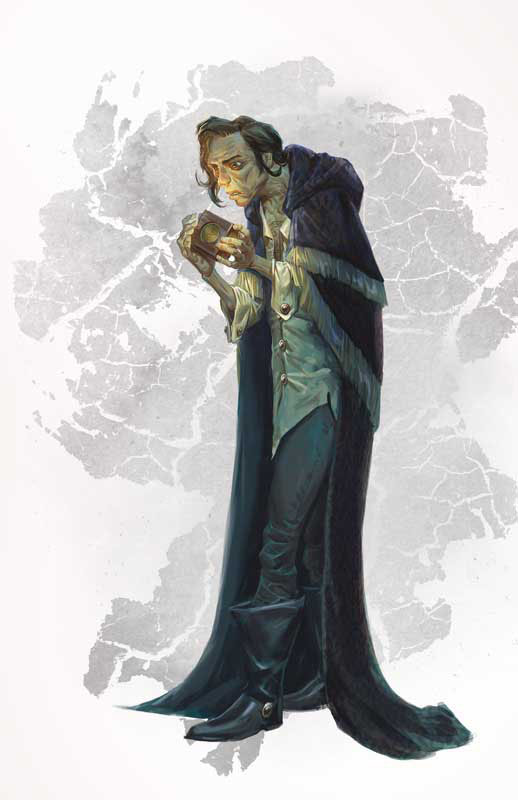 Thurstwell’s imp spies can be found throughout the Vanthampur Investigations. As previously discussed, you’ll want him to take meaningful action in response to what his imps see. Options include:
Thurstwell’s imp spies can be found throughout the Vanthampur Investigations. As previously discussed, you’ll want him to take meaningful action in response to what his imps see. Options include:
- He sends an imp to barter with the PCs. (He’d probably like them to kill one or both of his brothers. If he’s feeling daring, or if the PCs have already succeeded at eliminating his brothers, he might even ask them to kill his mother so that he can take her place at the head of the family. If the PCs were to go all in on this, you could have an alternate trajectory where, the job done, he asks them to take the infernal puzzlebox to Candlekeep and have it opened.)
- He sends a murder squad of Dead Three Cultists (Descent Into Avernus, p. 28) to kill the PCs.
- He sends an abduction squad to kidnap a refugee that the PCs care about so that he can use them as leverage. (Maybe to leverage them into an alliance. Maybe to force them to back off.)
V13. THURSTWELL’S BEDROOM
In addition to the normal key entry for his room (DIA, p. 35), this room includes a work table covered in papers, books, and other items. On this table can be found:
- The infernal puzzlebox.
- The Thurstwell’s Correspondence
- A draconic mask made of bronze with a strange glaze upon its face. The mask shimmers different colors depending on the angle you look at it, varying from black to blue to green to red to white. (GM Note: This mask taken from the Tiamat relics stolen from the Hhunes, see the Dungeon of the Dead Three.)
THURSTWELL’S CORRESPONDENCE
My dear Thirsty,
It’s done. I’ve sent word to Vaaz. We’ll be rid of the oaf soon enough.
I could use more of your divinations, though. My research using Elturgard’s armorial rolls suggest that the Majerus family were quite bountiful with their loins both during and after their service to the Companion. Given how many brats they seem to have had, they were probably rutting in their saddles. It’s likely they have any number of heirs in the refugee camps, so I think it’ll be well worth your time to cast forth your seventh eye or whatever and identify them for me.
Amrik
GM NOTE: The armorial rolls identify the name, coat of arms, and date of accolade for every knight in the Order of the Companion and the Riders of Elturel. See Part 3H: Trafficking Amrik.

Acting Resume
ROLEPLAYING GAMES Gamemastery 101
RPG Scenarios
RPG Cheat Sheets
RPG Miscellaneous
Dungeons & Dragons
Ptolus: Shadow of the Spire
Alexandrian Auxiliary
Check These Out
Essays
Other Games
Reviews
Shakespeare Sunday
Thoughts of the Day
Videos
Patrons
Open Game License




Archives
Recent Posts
- The Vladaam Affair – Part 13B: Magi Guildhouse – 1st Floor
- Advanced Gamemastery: Adversary Rosters
- The Vladaam Affair – Part 13: Red Company of Magi
- 5E Monster: Pearl Golem
- 5E Monster: Jewel Golems
Recent Comments
- on Xandering the Dungeon – Addendum: How to Use a Melan Diagram
- on Ex-RPGNet Review: Big Eyes, Small Mouth – Fast Play Rules
- on RPGs: The Essential Reading List
- on 5E Monster: Pearl Golem
- on Random GM Tip – Batching Initiative
- on Random GM Tip – Batching Initiative
- on Random GM Tip – Batching Initiative
- on Session 0 Module: Shared History
- on Random GM Tip – Batching Initiative
- on RPGs: The Essential Reading List

